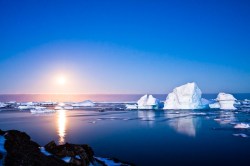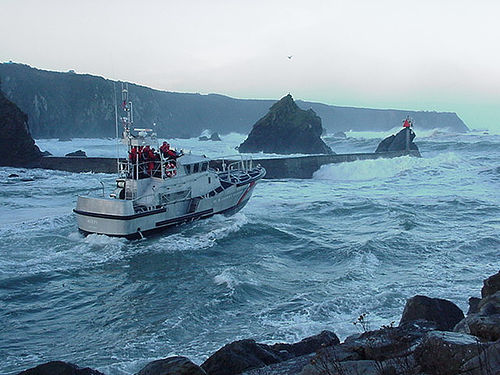
ShutterstockSmooth sailing?
For a ship on a mission of worldwide importance, the Yong Sheng is a distinctly unimpressive sight. The grey and green hull of the 19,000-tonne cargo vessel, operated by China‘s state-owned Cosco Group, is streaked with rust, while its cargo of steel and heavy equipment would best be described as prosaic.
Yet the Yong Sheng’s journey, which began on Aug. 8 from Dalian, a port in northeastern China, to Rotterdam, is being watched with fascination by politicians and scientists. They are intrigued, not by its cargo, but by its route — for the Yong Sheng is headed in the opposite direction from the Netherlands and sailing towards the Bering Strait that separates Russia and Alaska. Once through the strait, it will enter the Arctic Ocean, where it will attempt one of the most audacious voyages of modern seafaring: sailing through one of the Arctic’s fabled passages, the Northern Sea Route.
The passage, which hugs the coast of northern Russia, and its mirror route, the Northwest Passage, which threads its way through the islands and creeks of northern Canada, have claimed the lives of thousands of sailors who tried for centuries to cross the Arctic in an attempt to link the ports of the Far East and Europe by sailing via the north pole. Thick pack ice, violent storms and plummeting temperatures thwarted these endeavors.
But global warming has transformed the Arctic in recent years, and its summer ice cover has dropped by more than 40 percent over the last few decades, raising the prospect that it may soon be possible to sail along the Arctic’s sea routes with ease — a notion that is proving irresistible to shipping lines, not to mention mining companies as well as oil and gas exploration firms. All believe the region is ripe for exploitation.
Several fairly large ships have already sailed the Northern Sea Route. However, the voyage of the Yong Sheng, backed by the Chinese government, has special significance. This is the first attempt by the world’s biggest exporter to exploit the Arctic’s disappearing ice to reach its biggest market — the European Union.
“We always knew global warming would affect the planet first in the Arctic, but we have been floored by the rapidity of that change,” said Mark Serreze, director of the U.S. National Snow and Ice Data Center in Colorado.
“Temperatures have risen dramatically. At this rate, I would expect the Arctic to be completely free of ice in summer by around 2030. That is why everyone has become so interested in the region.”
The attraction for China in opening up the Northern Sea Route is straightforward. According to Cosco, the Yong Sheng’s 3,380-mile journey will take about 35 days, shaving two weeks off the traditional route between Asia and Europe via the Suez Canal.
“The Arctic route can cut 12 to 15 days from traditional routes, so the maritime industry calls it the Golden Waterway,” Cosco said when it announced the Yong Sheng’s voyage. For good measure, the new route will avoid the pirate-infested waters of the Indian Ocean and the Red Sea.
Making such cuts in transport times means major savings in fuel and lower costs for its products, hence China’s new enthusiasm for all things polar. Although its border goes nowhere near the Arctic, China recently gained observer status in the Arctic Council, a group of nations — Canada, Denmark, Finland, Iceland, Norway, Russia, Sweden and the United States — with major interests in the region. China, whose total foreign trade was worth $3.87 trillion last year, can see clear economic benefits from exploiting the warming that is gripping the planet and shrinking its northern sea ice shelves.
This point was stressed by Professor Qi Shaobin of Dalian Maritime University in China. Opening up the Arctic “will change the market pattern of the global shipping industry because it will shorten the maritime distance significantly among the Chinese, European and American markets,” he told Chinese state media last week.
And shipping figures certainly look encouraging. Russian authorities said last week they had already granted permission for more than 370 ships to sail the route this year. In 2012, only 46 ships sailed the entire length of the passage from Europe to Asia, while in 2010 only four vessels made the voyage.
In the wake of these figures, several proposals have been announced to take advantage of the expected expansion in Arctic shipping. Iceland is considering plans, backed by German entrepreneurs, to build a major port on its northeastern shores. Similarly, Stornoway Port Authority in Scotland said last month that it was considering building a special port for Arctic ships so they could refuel and discharge cargoes into smaller vessels for onward shipment to Rotterdam, Le Havre, Liverpool, or London. In addition, Valentin Davydants, captain of Russia’s Atomflot fleet of nuclear-powered icebreakers, has estimated that 15 million tons of cargo will use the full Northern Sea Route by 2021.
It sounds impressive until you realize that 929 million tons of cargo was shipped through the Suez Canal by 18,000 vessels in 2011. By that standard, the Northern Sea Route has still got a long way to go in transforming world shipping.
And other issues affect the attractiveness of sailing in Arctic waters. The seas around the north pole may be losing their summer ice cover, but there is still the everpresent danger of icebergs and drifting slabs of pack ice.
“Satellite photographs may suggest an area is completely clear of ice, but there is still a chance that a ship will encounter drifts of ice,” said Serreze. “It is very unlikely that the Yong Sheng will go through these waters on its own. The Russians have the best, most powerful armada of ice-breakers. Some of these are huge nuclear-powered vessels, and I would expect one of these will have been hired to escort the Yong Sheng on the main part of its journey.”
The last point is crucial. The Arctic Ocean will eventually lose its sea ice cover for several months in summer, but this is not likely to occur for a couple of decades.
For the foreseeable future, the Northern Sea Route will therefore be open for only a few weeks in summer and still require ice-breaker escorts. These factors will severely limit the route’s potential in the short term, a point stressed by Zhang Yongfeng, a researcher at the Shanghai International Shipping Institute.
“The navigable period of the passage is relatively short, while the port and pier infrastructure along the route is incomplete,” he told Fox News.
Then there is the major expansion of the Panama Canal, expected to be completed by 2015. When that happens it will be possible to take ships that have more than double the upper cargo capacity on vessels currently allowed in the canal. Again, the major beneficiary is expected to be China with its voracious export plans. The costs of shipping its goods to the eastern U.S. are predicted to drop by more than 30 percent as a result of the Panama’s expansion.
“For the next decade, I would have thought that the expanded Panama canal will have a far greater impact on world trade than opening up routes in the Arctic,” Serreze said.
Others disagree, however. One estimate suggests that between 5 percent and 15 percent of China’s international trade could use the Arctic route by the end of the decade. And where China leads, the world is very likely to follow.
Ice peril means northern sea route will not be smooth sailing
There are two main sea routes through the Arctic Ocean. The Northern Sea Route, or the Northeast Passage as it is also known, hugs the coast of northern Russia between the Bering Strait in the east and the north cape of Norway in the west. The other route, the Northwest Passage, lies at the opposite edge of the Arctic Ocean and threads through the channels and islands that pepper the coast of Canada between Greenland and Alaska.
The shipping line Cosco’s decision to take the Northern Sea Route, rather than the Northwest Passage, will have been a straightforward one.
Winds whip off Siberia and blow the sea ice that forms on its coast into deeper water. As a result, Arctic sea ice is generally thin along the eastern edge of the Arctic, along the Siberian coast, where the Northern Sea Route passes. This means that when temperatures rise, as they have been doing for the last few decades in the region, this will be one of the first places in the Arctic Ocean where sea ice — already thinned — will melt and disappear in the summer months.
Conditions along the Northwest Passage are far less favorable. Winds drive ice floes into the region’s myriad channels and creeks which can become blocked by thick ice for years — as mariners have found to their cost.
All 129 men on John Franklin’s expedition — which set sail from England in 1845 — died when his two ships, Erebus and Terror, became trapped in thick ice. The route was not conquered until the Norwegian explorer, Roald Amundsen, navigated it between 1903 and 1906.
By contrast, the Northern Sea Route had been conquered several decades earlier when the Swedish explorer Adolf Nordenskiöld sailed his ship Vega through the passage in 1879.
The voyage of the Yong Sheng through the Northern Sea Route will not be without its hazards, however. Satellite images provided by the American National Snow and Ice Data Center last week indicate that there are still significant amounts of sea ice blocking the route around the Taymyr peninsula in Siberia.
“Arctic sea ice does not reach its minimum extent until mid-September,” said ice data center director Mark Serreze. “Last year it dropped below 4 million square kilometers [2.5 million square miles] — the lowest, by far, that we have recorded since we began satellite monitoring of the region. However, this year the weather has been cooler and sea ice coverage will certainly not drop to last year’s levels. That means there will be more sea ice en route and more danger. The Yong Sheng will certainly need the help of an ice-breaker.”
Nonetheless, scientists do agree that summer sea ice in the Arctic will disappear sometime this century. Cover has dropped at a rate of around 13 percent every 10 years for the last few decades. Some believe this rate is accelerating and expect all summer sea ice to disappear in a few years. Serreze predicts 2030; others say it will not be gone until around 2040 or 2050.
Most agree about the cause, however: carbon emissions from factories, power plants, and cars are inexorably raising global temperatures and triggering major changes in the Arctic.
 This story originally appeared on the Guardian website as part of the Climate Desk collaboration.
This story originally appeared on the Guardian website as part of the Climate Desk collaboration.



